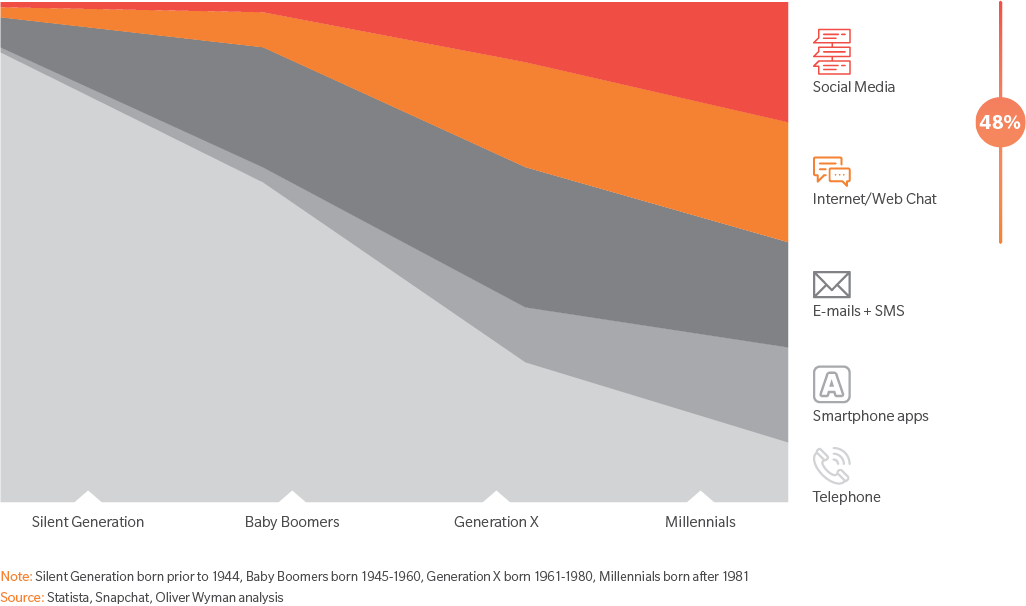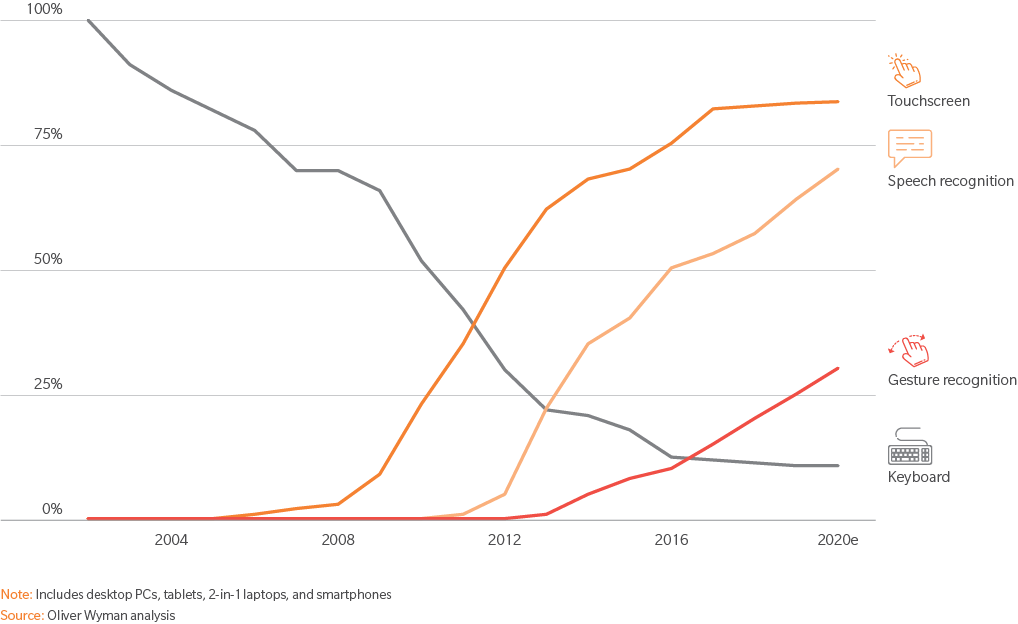Information flow is increasingly the world’s currency and open to a widening share of the world’s population – 230 million new users are being added to the Internet each year. Data availability is supporting step changes in performance, return on investment, and sustainable development. For example, design virtualization is reducing aircraft time-to-market by 15 percent, while airlines have realized $30 billion in fuel savings over the past 15 years due to data-driven productivity improvements.
The consequences of this shift in economic drivers for every sector is massive, including travel, transport, and logistics. Agile companies that champion user experiences and efficiently exploit data to that end are the most likely to benefit as this latest economic wave matures.
FROM CONSUMPTION TO EXPERIENCE
While most purchases are still being made in person, community sharing and social networks are creating hundreds of new consumer experience touchpoints that strongly influence sales. For example, 84 percent of car buyers use digital content at some point in their path to purchasing a car. As a result, the average number of showroom visits has dropped from six to 1.6. Nearly half of Millennials prefer social media and the Internet/ web chat as their primary contact points with businesses.
In this new environment, brands can no longer rely on consumer loyalty to protect them, no matter the excellence of a service or product. User experience is the key criterion and the source of value creation.
Companies across diverse industries are beginning to realize this and focus on improving the user experience. Examples: passenger airlines and rail operators that offer integrated journey services; delivery logistics firms that customize products and provide up-to-the-minute predictive updates; and hotels that allow customers to select a specific room ahead of time and then use their mobile device as a key.
Success in the new experience economy is all about staying ahead of the curve. This means that touchpoints must be constantly re-evaluated, as the ways in which consumers interact with digital technologies change. Mobile is currently eclipsing desktop, but the Internet of Things and autonomous chat devices (such as Amazon’s Alexa) are edging onto the scene. Keyboards gave way to touchscreens, which are being overtaken by speech and gesture recognition today, and likely virtual reality devices tomorrow. Every such change engenders new demands from consumers in terms of experiences and interactions.
FROM EXPERIENCE TO CUSTOMIZATION
The speed of change in consumer technologies and social media channels makes the purchasing journey a moving target, increasing the importance of personalization – the turning of goods and products into customized experiences. The era of the standardized offer and impersonal website is over: In a recent UK study, nearly 30 percent of consumers said they would stop visiting websites that lacked personalization. And 86 percent of consumers say personalization plays a role in their purchasing decisions.
In our estimate, various personalization channels offer the potential to increase revenues by 10-25 percent. In particular, personalization can be a strong lever for companies seeking to regain competitiveness versus market leaders.
As an example, a frequent business traveler searching for a trip to New York might have her search results sorted to prioritize an airline on which she has status, automatically suggesting her preferred aisle seat and offering to book a black car pick-up at the airport and a hotel downtown with several business amenities that is opposite her office.
A different traveler with identical search terms might instead be shown a vacation package with a budget-friendly airline, a family-friendly hotel located in Times Square, and suggestions for a city tour and theater show booking, because he has been identified as a leisure traveler vacationing with his family.
MOST POPULAR CHANNELS FOR CONTACTS BY BUSINESSES
PERCENT BY GENERATION, 2015, WORLDWIDE

In this environment, design, simplicity, and speed are paramount. Increasing the personalization of customer experience touchpoints has been shown to increase willingness to pay, willingness to switch brands, and willingness to try recommended products by double digits.
FROM CUSTOMIZATION TO THE DATA ECONOMY
In an economy where each client contact point is both an opportunity and a threat, the ability to manage, analyze, and value data has become fundamental to success. But if data is the new oil of the economy, it is largely untapped as yet. It is estimated that nearly all of the world’s stored data has been generated in just the past few years, but only about one percent has been analyzed and valued.
Collecting data is no longer the tough part – it’s identifying the 20 percent of data that will generate the biggest impact, integrating it across multiple sources into existing business models, and converting it into value. About a third of the value of data is in increasing operational efficiency and supporting real-time analysis and decision making. But we estimate that two-thirds of the value of data today is in how it can be used to enhance customer experiences and increase personalization.
Rather than boiling down the ocean of big data to extract big insights (a time- and resource-consuming process), capitalizing on the emerging data and experience economy will require a “smart data” approach instead: starting with the impacts a company wants to have, determining the actions and insights needed to drive those impacts, and only then extracting and exploiting the data most likely to fuel that process.
There is no room to stand still in today’s rapidly shifting, unpredictable technology and consumer landscape. Focusing on experiences, personalization, and smart data are tools that can help all companies keep on dancing even as the music changes.
PERCENT USAGE OF CONSUMER DEVICE INTERFACES






